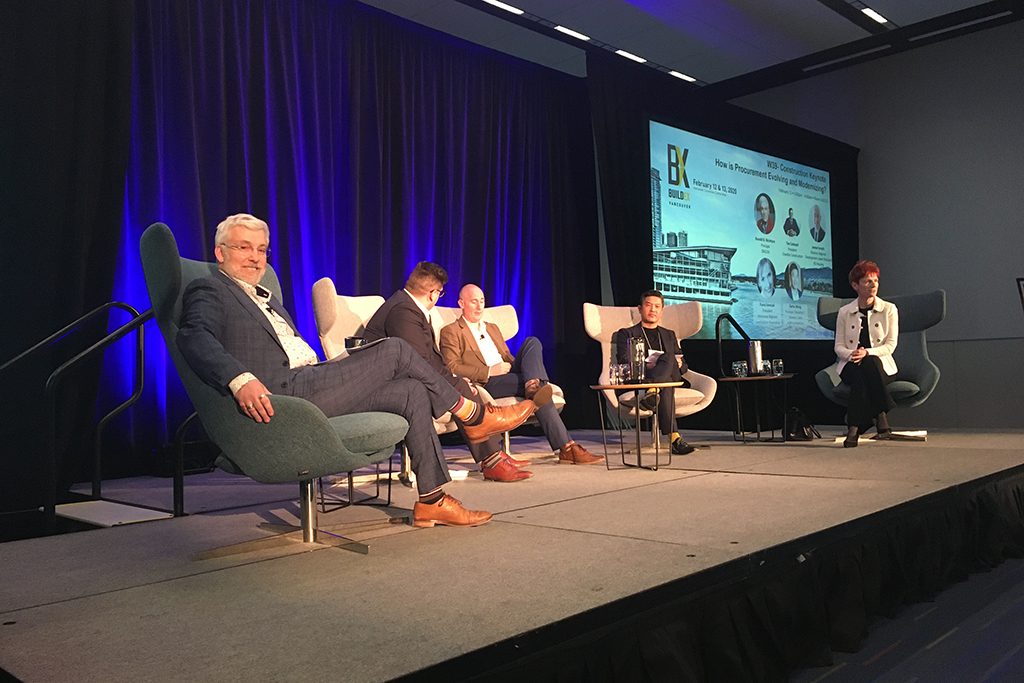Construction experts gathered for the Construction Keynote at Buildex Vancouver to chat about how procurement is evolving and modernizing.
Tim Coldwell, president of Chandos Construction, kicked things off by explaining how the industry’s growing complexity will push projects towards collaborative delivery methods.
“I think the built world has been getting much more complicated than it was 50 or 60 years ago. There are more stakeholders and much more technology involved,” said Coldwell. “There is a place for hard-bid procurement but as projects get more complicated you can’t get the value out of the whole supply chain without using some form of collaborative delivery.”
Chandos is a strong proponent of integrated project delivery (IPD) but Coldwell says social procurement is also becoming a larger part of projects.
James Forsyth, director of regional development for BC Housing in the lower mainland, said the agency is poised to spend around $7 billion on new construction projects and $1 billion on retrofits in the next 10 years to address the province’s housing crisis.
“We are keen to ensure that those dollars are spent in a way that brings value,” said Forsyth.
The agency mostly works with non-profit societies but also is starting to work more and more with developers and municipalities. He noted that the early stages of these projects are crucial for their lifetime of service.
“The procurement strategies that we implement are critical for that success,” said Forsyth, adding that using pre-qualifications, two-stage procurement processes and integrated project delivery are just some of the delivery methods the agency is exploring.
The agency is also being asked more and more to not just provide housing in its projects, but to make sure buildings have high energy performance.
Dathe Wong, a principal for HDR Architecture, explained that architects are increasingly being tasked with designing buildings around the wholistic goal of wellness.
“I think these issues are best tackled with broad-based expertise in a collaborative way,” said Wong. “IPD, alliance agreements, collaborative design-build – all of these help align incentives and create the right behavior.”
Wong is currently part of a team working on the largest IPD project in Canada, a nuclear lab.
“We are spending much less time arguing with each other and actually focusing our efforts into delivering great projects,” Wong said.
Fiona Famulak, president of the Vancouver Regional Construction Association (VRCA) which organized the keynote, stated that the industry is being asked to build higher-performance buildings amidst a labour shortage and rising population.
“The industry needs to build faster, greener and more productively than ever before and in order to do that we need to get the procurement process right,” said Famulak. “And we are hearing from our members that the procurement process is broken. The various delivery models are not understood in a way that they need to be.”
How does one fix a broken system? Panelists agreed there is no easy fix, but there were steps that could be taken to improve things.
Coldwell suggested general contractors should treat others how they want to be treated.
“We as generals hate being treated like commodities,” he said. “What’s good for the goose is good for the gander, and general contractors should lead the way and embrace collaborative and value-based selection in our supply chain.”
Forsyth used a recent example from BC Housing as they worked to implement the province’s new energy Step Code into projects.
“If you take a collaborative approach with your team from day one, rather than inserting a few lines into a specification document and allow those teams to be creative, I think that is how you can bring some fun back into it,” Forsyth said. “If you let teams have that opportunity, I think they will achieve great things.”
Famulak said the industry needs to work harder at building trust.
“We have to collaborate, we have to address the ‘T’ word in the industry. The trust word,” said Famulak. “There isn’t much of that.” “We need to collaborate – truly collaborate – and not just cooperate per contractual requirements. That means authentically sharing ideas and creating spaces to have value-driven conversations.”











Recent Comments
comments for this post are closed